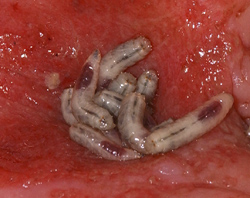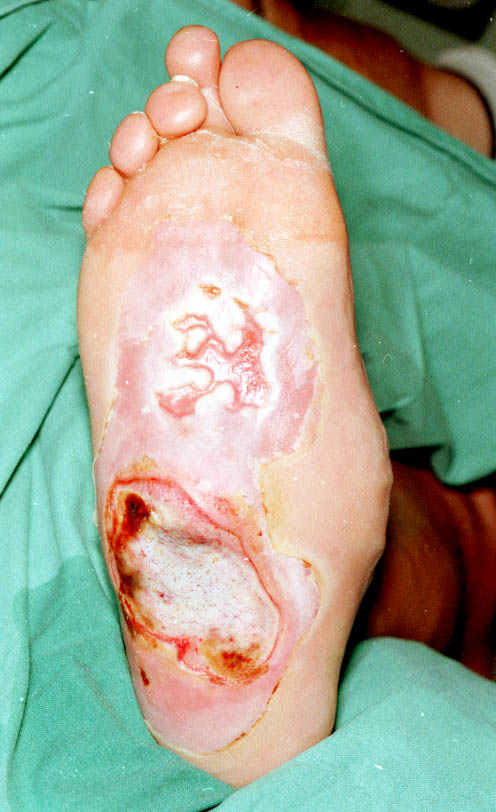Maggot therapy (also known as maggot debridement therapy (MDT), larval therapy, larva therapy, larvae therapy, biodebridement or biosurgery) is a type of biotherapy involving the intentional introduction of live, disinfected maggots (fly larvae) into the non-healing skin and soft tissue wound(s) of a human or animal for the purposes of selectively cleaning out only the necrotic tissue within a wound (debridement), disinfection, and promotion of wound healing.
Early history
Written records have documented that maggots have been used since antiquity as a wound treatment.[1] There are reports of the successful use of maggots for wound healing by Maya Indians and Aboriginal tribes in Australia. There also have been reports of the use of maggot treatment in Renaissance times. During warfare, many military physicians observed that soldiers whose wounds had become colonized with maggots experienced significantly less morbidity and mortality than soldiers whose wounds had not become colonized. These physicians included Napoleon’s general surgeon, Baron Dominique Larrey, who reported during France's Egyptian campaign in Syria, 1798–1801, that certain species of fly destroyed only dead tissue and had a positive effect on wound healing.[2]Dr. Joseph Jones, a ranking Confederate medical officer during the American Civil War, is quoted as follows, "I have frequently seen neglected wounds ... filled with maggots ... as far as my experience extends, these worms only destroy dead tissues, and do not injure specifically the well parts." The first therapeutic use of maggots is credited to a second Confederate medical officer Dr. J.F. Zacharias, who reported during the American Civil War that, "Maggots ... in a single day would clean a wound much better than any agents we had at our command ... I am sure I saved many lives by their use." He recorded a high survival rate in patients he treated with maggots.[3]
During World War I, Dr. William S. Baer, an orthopedic surgeon, recognized on the battlefield the efficacy of maggot colonization for healing wounds. He observed one soldier left for several days on the battlefield who had sustained compound fractures of the femur and large flesh wounds of the abdomen and scrotum. When the soldier arrived at the hospital, he had no signs of fever despite the serious nature of his injuries and his prolonged exposure to the elements without food or water. When his clothes were removed, it was seen that "thousands and thousands of maggots filled the entire wounded area." To Dr. Baer's surprise, when these maggots were removed "there was practically no bare bone to be seen and the internal structure of the wounded bone as well as the surrounding parts was entirely covered with most beautiful pink tissue that one could imagine." This case took place at a time when the death rate for compound fractures of the femur was about 75-80%.[citation needed]
Modern use
While at Johns Hopkins University in 1929, Dr. Baer introduced maggots into 21 patients with intractable chronic osteomyelitis. He observed rapid debridement, reductions in the number of pathogenic organisms, reduced odor levels, alkalinization of wound beds, and ideal rates of healing. All 21 patients' open lesions were completely healed and they were released from the hospital after two months of maggot therapy.
After the publication of Dr. Baer's results in 1931,[4] maggot therapy for wound care became very common, particularly in the United States. The Lederle pharmaceutical company commercially produced "Surgical Maggots", larvae of the green bottle fly, which primarily feed on the necrotic tissue of the living host without attacking living tissue. Between 1930 and 1940, more than 100 medical papers were published on maggot therapy. Medical literature of this time contains many references to the successful use of maggots in chronic or infected wounds including osteomyelitis, abscesses, burns, sub-acute mastoiditis,[5][6] and chronic empyema.[7]
More than 300 American hospitals employed maggot therapy during the 1940s. The extensive use of maggot therapy prior to World War II was curtailed when the discovery and growing use of penicillin caused it to be deemed outdated. Due to the lack of conventional medicines, maggot therapy was used by Allied military medical staff in Japanese prisoner of war camps in the Far East throughout World War II.[8]




0 people drop their comments!:
Post a Comment